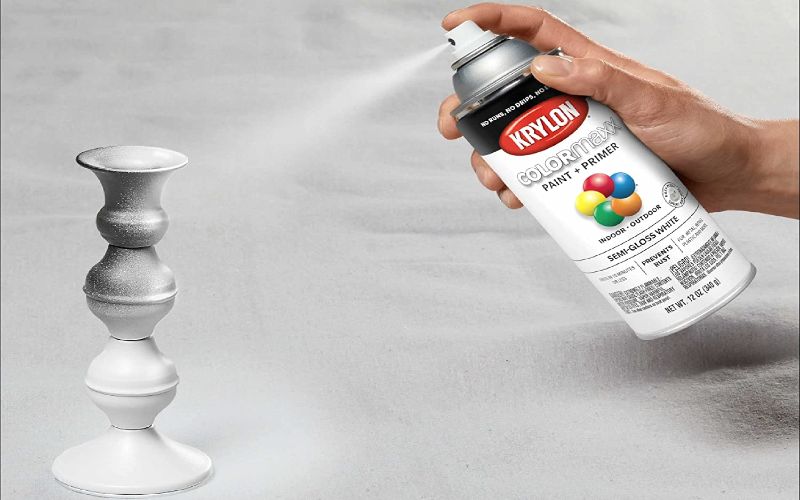Rustoleum vs Krylon debate will never go away as they are leading brands in the protective coating industry.
These two products have been around for several years.
Professional painters, amateurs, and DIY enthusiasts use these products for different projects.
Also, there are divergent opinions and preferences regarding the usability and durability of the products.
These differences in opinions make it a nightmare to select a brand for a project, especially if you have never used them before.
But worry not because I’ll discuss the properties of Rustoleum Vs Krylon side by side in this article to make it easier to find what works best for you.
Rustoleum is known for creating durable products that resist rust and other surface corrosion.
They are the best choice for outdoor projects.
The Rustoleum company has been producing coating products for more than 100 years, and it started by only manufacturing metal coatings.
Over the years, it has widened its product line to include a variety of finishes suitable for other surfaces like wood, plastic, fabric, concrete, etc.
On the other hand, Krylon is known for creating easy-to-use aerosol paints in various colors and sheens.
They are prevalent for making products like the Fusion all-in-one, which adhere to sleek surfaces like plastic and tiles without sanding or priming.
You can use Krylon products for coating many surfaces, including wood, masonry, and metal.
However, when it comes to metal, Krylon products work well, but they don’t offer as much protection as Rustoleum.
This is just a rundown of the main things you need to know about Rustoleum vs Krylon.
So, let’s dive deeper into their individual properties to help you understand them better.
I’ll compare and contrast all their functional and physical properties to help you make a more informed choice.
What Is Krylon?
 Krylon started as a manufacturer of clear brush-on acrylic protective coatings mainly used in commercial art businesses.
Krylon started as a manufacturer of clear brush-on acrylic protective coatings mainly used in commercial art businesses.
Soon, Kester, one of the founders, got inspired by the DuPont Corporation’s creation of a dispersal formula that combined gas and liquid in a spray container.
Kester found a way to create aerosol products that were easier and faster to apply than the brush-on varieties.
In short, Krylon became the first supplier of aerosols in the world.
At first, Krylon only produced clear aerosol coatings, and its sales were still limited to the art and advertising trades.
However, the company started adding color to the products in the early 1950s, creating more usage options, and sales multiplied.
Their color collections are fantastic, offering all shades to match your painting surface.
They even produce paints with specialized features like glitter or mirror effects, giving you more room to get creative.
Today, Krylon is still the largest supplier of aerosols in the world.
Over the years, they have improved their packaging and spray mechanism to help consumers apply their products quickly and evenly.
They make products for indoor and outdoor projects, and you can use them on many surfaces, including wood, metal, fabric, and plastic.
Apart from the easy and quick application, the other feature that makes Krylon products stand out is their ability to dry quickly.
The paints harden in minutes, making them ideal if you have a rush project but still want to end up with a durable paint film.
What Is Rustoleum?
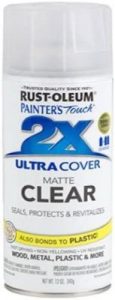 Rust-Oleum is one of the most prominent protective paints and coatings manufacturers for home and industrial use.
Rust-Oleum is one of the most prominent protective paints and coatings manufacturers for home and industrial use.
It was founded by a sea captain called Robert Fergusson after accidentally spilling fish oil on his rusty metal decks.
The captain noticed that the oil stopped the corrosion from spreading further.
He then adopted the formula to create the world’s first rust-resistant paint, which sold successfully.
At first, Fergusson used whale oil to make the products, which worked beautifully.
However, it also contributed to whaling, which involved killing whales to obtain the blubbers that produced the oil.
Over the years, the company phased out whale oil, substituting it with resins gotten from alkyds, epoxies, latex, polyurethanes, etc.
As time went by, Rustoleum decided to expand its line of products to include coatings suitable for surfaces other than metal.
They created decorative and protective paints for wood, plastic, glass, concrete, etc.
They even have specialized paints like mirror paint and glitter paints which work well for decorating spaces.
However, their biggest strength remains on the metal coatings side.
On the downside, Rustoleum coatings take longer to dry. Hence they are not suitable for rush projects.
However, they are still the most durable products on the market; therefore, the long waiting time is still worth it.
Additionally, the Rustoleum products come in aerosol and brush-on varieties, allowing you to choose an application method that suits you the most.
Rustoleum Vs Krylon Comparison
We often consider many factors when selecting surface coating products.
For instance, we choose paints with excellent corrosion protection when painting surfaces in areas prone to moisture or other elements.
On the other hand, we select products with high adhesive qualities when working with sleek surfaces like plastic or glass.
Rustoleum and Krylon create products that have similar functions and application methods.
However, each brand has unique features that make them more suitable for some applications than others.
Therefore, in this section, we’ll look at the individual properties of Rustoleum Vs Krylon.
We’ll discuss coverage, durability, dry times, cost, etc., to help you make a more informed choice during purchase.
Similarities
Here are some of the similarities between the two products.
- Application
Rustoleum and Krylon use the aerosol application system, making it easy to apply.
The aerosol cans cut the application time in half, allowing you to finish projects quickly.
Moreover, they release the paint in thin mists that lay down thin coats, dry evenly, and you don’t have to worry about brush marks.
Even the brush-on products from Rustoleum go onto surfaces smoothly.
Moreover, if you do not want to apply them with a brush, you can thin them and use them in a sprayer instead.
- Uses
Rustoleum and Krylon create products you can use indoors or outdoors.
They also develop coatings for many surfaces; hence you will never lack something to use for whatever project you have.
For instance, if you intend to decorate a piece of fabric or paint a car or a plastic chair, you will find products specially made for those surfaces from both brands.
- Colors
Both brands have products in many colors and sheens, ranging from a very dull matte to the shiniest gloss.
You can combine the paints to create different shades if you can’t find what you want.
Even so, ensure you only mix Krylon with Krylon or Rustoleum with Rustoleum.
Even though both brands have many paint colors, Krylon has more colors giving you endless choices.
Differences
The differences are in their:
- Cost
Regarding cost, Rustoleum products are more affordable than Krylon, and the difference stems from the solvents each brand uses in its formula.
Rustoleum paints are enamels, while Krylon coatings are mostly lacquers. Lacquers always cost more than enamels.
Lacquer paints are more expensive than enamels because painters do not use them often.
Lacquers were the first choice when painters needed shiny hardshell paint jobs.
However, they required frequent waxing and buffing to maintain the shine, which proved to be hectic.
Therefore, paint manufacturers started making more durable enamel paints that stay shiny without much maintenance.
As a result, local paint stores and home improvement centers do not carry lacquer paints; hence you can only find them in pricey autobody supply shops.
On the bright side, you can find any paint today because of the introduction of online shops.
When you compare the prices of Krylon and Rustoleum, Krylon’s is always a little higher.
- Coverage
Rustoleum wins because their products cover surfaces comprehensively with few coats – usually one or two.
The reason is that the Rustoleum formula is thicker than Krylon’s; hence its coverage is superior.
Don’t get me wrong, you can get excellent coverage with Krylon paints, but you will have to use more coats to reach the coverage level of Rustoleum.
- Durability
Both Rustoleum and Krylon products are durable, but Rustoleum coatings are tougher.
The reason is that Rustoleum coatings are enamels and dry into more rigid coatings than the Krylon lacquers.
Moreover, when enamel paints dry, they remain hard for a long time and can resist UV and chemical damage.
On the other hand, Krylon paints are lacquers, which are softer than enamel paints even when fully dry.
For this reason, they chip and scratch more easily.
Moreover, lacquer paints have low UV resistance, contributing to quick degradation.
Since the Rustoleum products are more durable, most painters prefer to use them for outdoor projects, while Krylon paints work better indoors.
- Drying and Curing Time
When it comes to drying, Krylon products dry faster than Rustoleum’s.
The reason is that most Krylon paints are mostly lacquers, and lacquers usually dry fast because they don’t need any additives to harden.
Once the paint solvent evaporates, the resins solidify. The only problem is that reintroducing a solvent to a dry lacquer film softens again.
On average, the coatings take 15 minutes or even less to dry to the touch.
However, the times will vary depending on the product, so always read the label to be sure.
The Rustoleum products take longer to dry because they have a thicker formula that needs longer to dry to achieve the best protection for your surface.
On average, they dry to the touch in 2-4 hours, and you can only handle the painted surface after about 5 hours.
They dry fully in 24 hours, but the drying times vary from product to product, so always read the labels.
Pros of Rustoleum Products
- They are durable; hence they can withstand harsh conditions.
- They have a thick formula; hence they cover sufficiently with few coats.
- They are more affordable than Krylon.
- Rustoleum products come in various colors and sheens.
- They are easy to apply.
- You can use them indoors or outdoors.
Cons of Rustoleum Products
- They take too long to dry.
Pros of Krylon Products
- They dry quickly
- They come in several sheens and colors.
- They are all aerosols; hence they are quick and easy to apply.
- You can use them on many surfaces, both indoors and outdoors.
Cons of Krylon Products
- They cost more than Rustoleum.
- You need to apply several coats for optimum coverage.
- They deteriorate faster than Rustoleum.
Can You Paint Krylon Over Rustoleum?
You cannot paint Krylon over Rustoleum because of two reasons:
First, Krylon products are lacquers, while the Rustoleum ones are enamels.
When you apply lacquer over an enamel, the enamel coat will “burn” or lift off the surface.
The reason is that the solvents in lacquers (lacquer thinners) are more potent than the mineral spirits or acetone used in enamel paints.
Therefore, when you apply lacquer over an enamel, it will eat away at the bottom coat and cause it to loosen its grip on the surface. As a result, it peels off.
Second, you cannot apply Krylon over Rustoleum because of the difference in their drying times.
The quick-drying Krylon will dry first, leaving the Rust-Oleum underneath tacky.
When the Rustoleum paint starts to harden, it will pull at the already dried top film, causing it to wrinkle.
If the situation worsens, the Krylon paint film will peel off instead of forming wrinkles.
I recommend you only use one brand for each project if you want to avoid such adverse reactions.
If you have no option but to use Krylon over Rustoleum, it is best to let the Rustoleum coating cure entirely before applying it.
Lacquers will work over most good-quality enamels, but there is no guarantee that the paint job will last.
Therefore, test the product in an inconspicuous area and allow it to sit for 24 hours before proceeding.
Can You Paint Rustoleum Over Krylon?
You can paint Rustoleum products over Krylon because their formula is compatible with most coatings.
Since it is enamel, it does not have any adverse reactions like what happens when you put Krylon over it.
Unlike lacquers which are only compatible with other lacquers, you can use enamel coating products over other enamels and lacquer without a problem.
The best combination is applying a Rustoleum clear coat over Krylon paint, especially when using Krylon paint for outdoor projects.
Since Rustoleum is more durable than Krylon, it will make the paint last longer.
It will prevent the color from becoming dull due to constant contact with the UV rays and keep the paint from chipping or scratching off.
You can also make Krylon paint last longer by applying Rustoleum paint over it as the final coat.
However, you must ensure that the colors of both paints are an exact match and that their solvent bases also match.
They should all be either water-based or oil-based.
Note: You can also apply an oil-based Rustoleum paint over a water-based Krylon paint but never vice versa.
Is Rustoleum Primer Enamel or Lacquer?
Rustoleum primers are enamels.
The Rustoleum company prides itself on creating durable products; therefore, they make enamel primers because they are more durable than lacquers.
You can determine this by checking the drying times indicated on the product’s packaging.
You will notice that they will need hours to dry and cure instead of the 15-30 minutes lacquers take to dry.
Traditionally, all Rustoleum enamel primers were oil-based.
The oil content allowed them to mix easily, go onto surfaces smoothly and adhere firmly for a long time.
However, there has been a heightened demand for non-toxic primer alternatives over the years, so they also started creating water-based enamel primers.
The water-based enamel primers are simpler to work with because they dry faster.
They are also easier to clean with water, meaning cleaning your painting tools and accidental spills is quite easy.
On the other hand, the oil-based versions last longer and provide a smoother and more durable finish.
However, You will need a harsh solvent like paint thinner to clean tools and spills efficiently.
For this reason, I always recommend using water-based enamels for basic indoor projects and oil-based enamels for outdoor projects.
How to Paint Rusty Metal With Rustoleum
Here are the steps involved in the painting of rusty metal using Rustoleum paint
Step 1: Prepare Your Work Station
- First, open all doors and windows to keep fresh air circulating in your work area.
This will keep you from inhaling paint fumes that would cause health risks.
If you can move your project outside, choose an open place far from people and pets to protect them from the fumes.
- Wear a respirator mask, goggles, and gloves to protect yourself further, especially if you use the spray-on Rustoleum products.
Next, lay down a drop cloth or several newspaper sheets to catch drips and stray paint mist.
- Finally, gather all the paints, primers, painting tools, cleaning tools, etc., in one place where you can reach them easily.
Doing this will allow you to work without moving around to look for what you need next.
Step 2: Inspect the Metal
Start by checking the extent of the rust on the metal to help you select the best products for your surface.
If any surface part is too corroded to salvage, replace it before proceeding to avoid future issues.
Step 3: Remove Rust and Old Paint
Begin by removing flaking paint and large chunks of rust using a wire brush or sandpaper.
- Run the brush or sandpaper over the surface continuously until all the large rust chunks flake away.
If you paint a large surface, use an electric sanding machine or a drill with a wire wheel to get the job done faster.
- Finish by dipping a clean rag in some acetone, then wipe the metal to remove remnant rust chunks, grease, and other stubborn dirt.
Step 4: Prime the Metal
Spray or brush on light coats of Rustoleum metal primer to get the paint to adhere better and prevent further surface corrosion.
If you are using the spray-on versions:
- Shake the aerosol can until the mixing ball begins to rattle, then keep shaking it for one minute to ensure that the product mixes well.
- Next, hold the paint can upright, 10 inches from the surface, then spray slowly and steadily back and forth.
Ensure you overlap each stroke to avoid leaving some surface parts without paint.
- One Rustoleum primer coat is often enough.
However, it is better to apply two coats in this case because the metal had rust on it.
Make sure that each layer dries thoroughly before applying the next one.
Ensure that you read the product’s label carefully to get the precise drying time recommended by Rustoleum.
If you are using the brush-on versions:
- Stir the primer with a wooden stick until it reaches a uniform consistency, then pour some of it into another container.
- Dip a paintbrush in the primer, then remove excess product by tapping the brush lightly inside the container.
You must load the paintbrush with a little primer to apply thinner coats that dry faster.
- Apply the primer thinly, overlapping each brushstroke to avoid leaving brush marks.
- Let the primer dry properly before applying a second coat.
These are the Rustoleum products that I recommend you use depending on the severity of the corrosion damage on the metal.
- Use the Rust-oleum rusty metal for heavily rusted metal.
Its powerful formula allows it to penetrate through the rust and bond directly to the bare metal.
As it penetrates through the rust, it also drives out the air and moisture that could cause further corrosion.
The result is a smooth foundation that topcoats can adhere to easily.
- The Rust-oleum clean metal primer is the best option for lightly rusted metal or previously painted metal.
It will seal down the existing rust, creating a smooth bonding surface for your topcoat.
- The Rust-oleum rust reformer is best if you want to avoid sanding altogether.
You can spray it right over the rusty surface, chemically converting the rust into a smooth, paintable surface that requires no sanding for the paint to adhere.
Step 6: Apply Paint
Once you have finished restoring the rusted metal, you can topcoat it with any Rustoleum paint.
You can add the topcoat within one hour, but you’ll need to wait 48 hours for the primer to cure if that’s too quick and you need to rest.
- Once you’re ready, spray on the paint carefully, just like you did the primer.
Apply at least two coats of color, allowing each layer to dry before applying the next.
Ensure that you follow the Rustoleum’s instructions for the right application conditions and dry times for the best results.
How to Paint With Rustoleum:
Do You Have to Remove Rust Before Painting Metal?
You don’t necessarily have to remove rust before painting metal because you can treat the corrosion using chemical methods.
The most popular way to maneuver this is by using a rust converter to chemically transform the rust into a smooth surface that you can paint.
Even though rust converters are effective, I still recommend scraping off loose rust before painting metal.
The task will require more time and effort but yield better results.
If you want to avoid the sanding altogether, I recommend using a chemical rust remover.
These products slowly dissolve rust, leaving a clean area to paint.
What Is the Difference Between a Rust Converter and a Rust Remover?
A rust converter and a rust remover are both products that provide different solutions to corrosion problems.
Many people know they are associated with rust but have no idea how they work or their differences.
Below is an in-depth look into both of them to give you better insight into which one is best for you.
-
Rust Converters
A rust converter is a chemical solution or primer that you apply directly over rusted metal.
It works by transforming the rust into a protective black barrier that is more resistant to moisture.
Therefore, it stops the metal below from eroding further.
Painters prefer these products on metals like aluminum, iron, or steel because they require stronger methods like sandblasting to remove the corrosion manually.
On the downside, rust converters don’t offer a lasting solution, especially on surfaces with heavy rust.
They only react with the rust’s surface instead of reaching whatever is below. For this reason, the metal may continue to rust even if you paint it.
-
Rust Removers
Rust removers, unlike rust converters, chemically dissolve rust, separating it from the surface.
As a result, they prevent further damage to the metal.
They are ideal when you need a permanent rust solution, like when painting corroded car parts.
If treating a large surface, it is best to apply the remover and then rub it with a wire brush every few minutes.
Constant rubbing ensures it remains active until all the rust dissolves.
For smaller metals, soak the object in the remover until you see the rust loosening, remove it, then wipe away the rust with a lint-free cloth.
Do I Need to Prime Metal Before Painting With Rustoleum?
Applying a metal primer before using Rustoleum paint is not always necessary.
Products like the 3800 System Direct to Metal ( DTM) Acrylic Enamel paint do not necessarily require a primer.
However, I recommend that you always start with a primer, especially if you’re painting an untreated metal that will be constantly exposed to moisture.
The chemical makeup of most paints – even metal paints – is less binding on metal.
The reason is that metals are sleek surfaces; therefore, they need the assistance of a good quality primer to allow the paint to grip their surface.
The primer will act as a magnet between the metal and the paint, keeping the color intact for longer.
The paint will flake off the metal surface in days or weeks without a primer.
The exposed parts of the surface will begin to oxidize and corrode immediately after they contact air and moisture in the atmosphere.
Soon, the rust will spread to the other parts of the metal, causing it to weaken, which jeopardizes the metal’s structural strength.
When choosing a primer, you must ensure that the packaging indicates it to be a rust inhibitor.
Rust inhibiting primers are designed specifically to prevent the metal from oxidizing.
For instance, the Rustoleum company makes rust-inhibitive primers by adding zinc to the formula.
Therefore, when the surface gets exposed to rust-causing elements, the zinc will oxidize in place of the metal.
The zinc will have to corrode and dissolve entirely before the bare metal gets exposed – a process that will take years.
On the bright side, not all metals require a primer before painting.
Some metals like stainless steel, galvanized steel, and copper contain rust-inhibitive properties; therefore, you can paint directly over them without problems.
Note: A metal like aluminum won’t rust, but its surface is too sleek to accept paint; therefore, you must use a primer or DTM paints for best results.
Is Krylon Paint Good for Metal?
Krylon is known for producing quality metal paints, but not all of its products are good for metal.
Some work only on fabric, while others work excellently on most surfaces except metal.
Metal paints need to have some specific characteristics for them to work efficiently.
For instance, they must have rust protective features to prevent metal corrosion and excellent adhesive qualities from sticking to the sleek metal surface.
Below are the Krylon paint series that the manufacturers designed specifically for metal or general applications but with rust protection.
1. Rust Tough® Krylon Paints
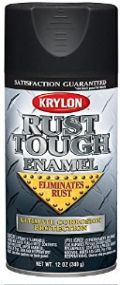 Krylon created these paints specifically for metal surfaces.
Krylon created these paints specifically for metal surfaces.
These products come in many rich colors which do not fade quickly, and they even stick to bare metal without needing a primer.
They fitted each product with anti-rust technology to help maximize metal protection, avoiding the damaging effects of outdoor environments.
The Rust Tough® paints come in spray cans with a comfort nozzle that allows you to spray easily in any direction – even upside down.
They also have brush-on formulas that work best for bigger projects.
Check Latest Price
2. Krylon Fusion All-In-One®
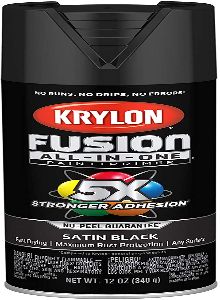 The Krylon Fusion All-In-One® products are the most popular among painters because they are all-purpose paints.
The Krylon Fusion All-In-One® products are the most popular among painters because they are all-purpose paints.
They adhere to almost anything – including wrought iron, metal, plastic, glass, wood, wicker, ceramic, and masonry.
These paints offer maximum rust protection, which is the feature that makes them suitable for metal.
They leave a durable, high-quality finish and have excellent adhesion capabilities; hence you do not have to worry about peels and lifts.
Moreover, you do not have to sand or prime these paints to get good results.
Check Latest Price
3. Krylon COLORmaxx Paints
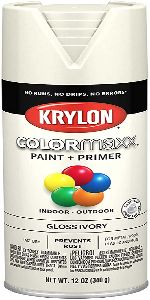 The Colormaxx paint series offers the most color options among the products on this list.
The Colormaxx paint series offers the most color options among the products on this list.
You can apply it on many surfaces, but its added rust protection makes it suitable for metal.
Moreover, Krylon formulated these products as paint and primer in one to help reduce surface prep time by cutting out the priming step.
Check Latest PriceHow to Paint Metal With Krylon
Here are the steps involved:
Step 1: Remove Old Paint and Rust
- Start by removing any visible rust flakes using a wire brush. If the surface has peeling paint, use a wire brush drill attachment or coarse grit sandpaper to do the job faster.
- If the metal has too much rust, soak it in a rust remover to eliminate the corrosion. Ensure that you read the instructions given by the remover’s manufacturer to avoid ruining the metal.
- Finally, wipe the metal with a rag dampened in acetone to remove remnant rust and stubborn dirt.
Step 2: Paint With Krylon
The Krylon products that offer rust protection do not require sanding or priming; hence, you can directly paint over the metal.
If your surface has rust, use the Rust Tough products only.
- First, keep your aerosol container at room temperature for at least 2 hours before use. Afterward, spray the paint onto a scrap piece of cardboard to ensure that the paint flows perfectly before directing the nozzle at your surface.
- Hold the sprayer approximately 6 inches from the surface and spray in a steady back-and-forth motion. Ensure you do not spray one area too long to avoid causing paint drips.
- Shake the spray container occasionally as you work to keep the paint flowing.
- If the nozzle becomes clogged, wipe it with warm water to remove the blockage. Next, hold the can upside down and press the nozzle until no more paint comes out.
3. Apply at least 3-4 layers of paint for maximum coverage. Allow each layer to dry for 15-30 minutes before recoating because Krylon paints Dry fast.
4. After the final coat, leave your surface for 48 hours before using it heavily.
Here’s How to Paint With Krylon:
Conclusion
Rustoleum and Krylon produce amazing coating products for all kinds of projects.
However, their differing properties make it difficult for painters, especially beginners, to know which brand will work best for their project.
This article compared
Rustoleum Vs Krylon
Rustoleum creates durable enamel products, which is the best product to choose when painting metal or any outdoor project.
The hard enamel coats are rigid and can withstand the constantly harsh outdoor environment.
Even though they work best outside, you can also use Rustoleum products for indoor projects.
On the other hand, Krylon products are also durable, but they are lacquers; therefore, they are not as durable as Rustoleum.
They work best for indoor projects, but you can also use them outside. They also offer the most color choices of the two brands.
You can apply Rustoleum products over Krylon because enamels do not affect lacquer.
However, when you use Krylon over Rustoleum, the Rustoleum coat will lift or wrinkle, so avoiding the combination is best.
I hope you now understand the differences and similarities between Rustoleum and Krylon.
Please reach out in the comments section if you need clarification on anything.
